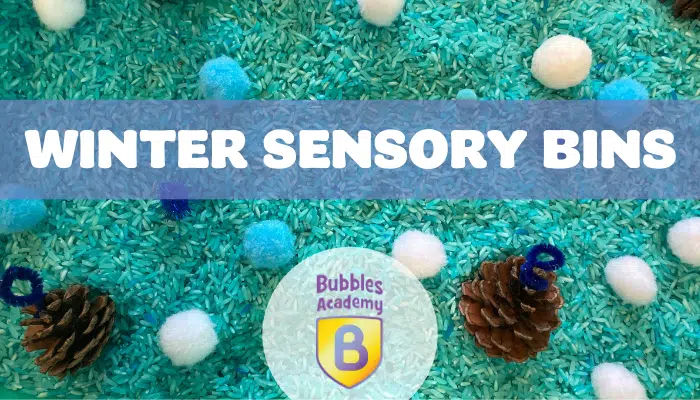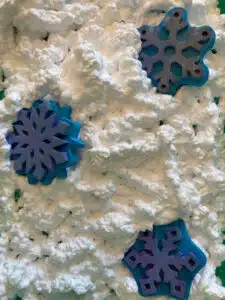Here at Bubbles we can talk all day about the amount of fun and exploration a good sensory bin can bring. As an open-ended activity, almost nothing can beat digging your hands into something textural, finding hidden pieces, or splashing around. But it’s important to remember that touch sensation is only one of the ways we process information. The best sensory bins engage multiple senses like items that make interesting noises, contain different smells, or look visually bright.
Sensory bins can be filled with almost anything. No need to run out and buy a bunch of supplies – just look around your house or backyard for some of the best supplies. I once read an article that mentioned that all you really need to make a sensory bin was water and a cup, and it blew my mind. It really can be that easy.
However, for people who want to expand upon the basic bin, here are a few ideas for some fun winter materials to create endless opportunities for seasonal sensory fun!
Snow!
A personal favorite exploration. There are a few ways we can emulate snow in a sensory bin.
- First, real snow – gather some when the snow is fresh on the ground. Yes, it will melt, but that’s a magical thing for our kids to get to watch and feel.
- Shaving cream makes a great snow alternative visually, but is a totally different textural element. The soft feeling and the clean smell make a Bubbles Academy fan favorite.
- For something a little less messy, cotton balls or pillow stuffing make a soft snow-like scene without the spills and stickiness
To turn any of these snowy studies into a winter forest scene, I love to add small plastic (easy to wipe down) wintery animals for the kids to search for in the “snow”.
Nature!
Taking a walk around your backyard or neighborhood to grab some materials for your next bin. Dried leaves, twigs, and pinecones all make great additions – Just be careful not to bring any unwanted critters in from your trip! This is also a fun way for our little ones to be a part of the bin building process as well. The activity gets expanded by having the collection aspect as a part of the whole journey. This is also a great way to explore what the season changes really look like: how does your nature bin look different in the winter than it does in the spring, summer, or fall?
Colors!
Using colors we associate with winter can make any materials into a seasonal bin specialties. This creates a visual theme as a part of the sensory experience. Classic blue, winter, and silver create a great winter scene or green and red make a holiday splash. With color as your starting point, you can go a couple different ways: lots of different types of items all fitting into your color story OR one specific item in a variety of colors to make the visual aspect the main differentiating sensation. Some great items for this type of bin:
- Fabric scraps
- Craft pom-poms
- Dried rice or pasta – Shake in a ziplock or tupperware with a little vinegar and food coloring and put in a warm space to dry entirely before use to keep your hands clean during play
- Cooked noodles – Similar dyeing process to the dried version, but replace the vinegar with vegetable oil and rinse under water after the noodles have been saturated with color.
- Crinkly tissue paper/foil – Also a great audio sensory for the kids to scrunch
- Packing peanuts
- Kinetic sand
- Dried play-doh chunks – A great way to reuse and recycle something that’s always around.
- Beads and buttons of different shapes and sizes
Smell!
I think this is the most underrated sense but can be so fun to incorporate into this kind of play and winter has such fun smells to use! My favorites:
- Cinnamon sticks
- Candy cane pieces – Just make sure they aren’t sharp
- Essential oils or cooking extracts – Get a couple drops on a cotton ball and put that cotton ball in a space pouch or sachet (like the ones earrings might come in) to keep the smell present without the mess or too strong a scent. I love lavender oil or vanilla extract.
When using items like these, please keep in mind all food safety or allergies for safe play.
Safety reminder: When building a sensory bin, please keep in mind the size/materials you’re using and keep an eye on your child’s playtime if you have any potential choking hazards.
Now that we’ve shared some of our favorite bins, what are yours? Share with us below!

Amelia Bell
Amelia’s been moving and grooving from day one. Her parents once told her that as a child she “wasn’t content until she could walk on her own.” Walking quickly turned into dancing, and she’s never stopped. Originally from Houston, Texas, Amelia spent her childhood trying to do anything she considered “artistic” until finally finding her passion in theatre and dance. She graduated from Northwestern University where she was a Theatre major, Dance minor, and graduated with a certificate in Music Theatre.
Working at Bubbles is a dream come true! The mixture of imagination, adventure, art, and music is perfect for Miss Amelia’s energetic and creative spirit. She has been working with young children since she was a teenager, and loves the opportunity Bubbles gives to combine her love of children with her love of the arts. When not working, she can be found on stage performing, teaching herself how to play musical instruments, and baking treats for friends!


